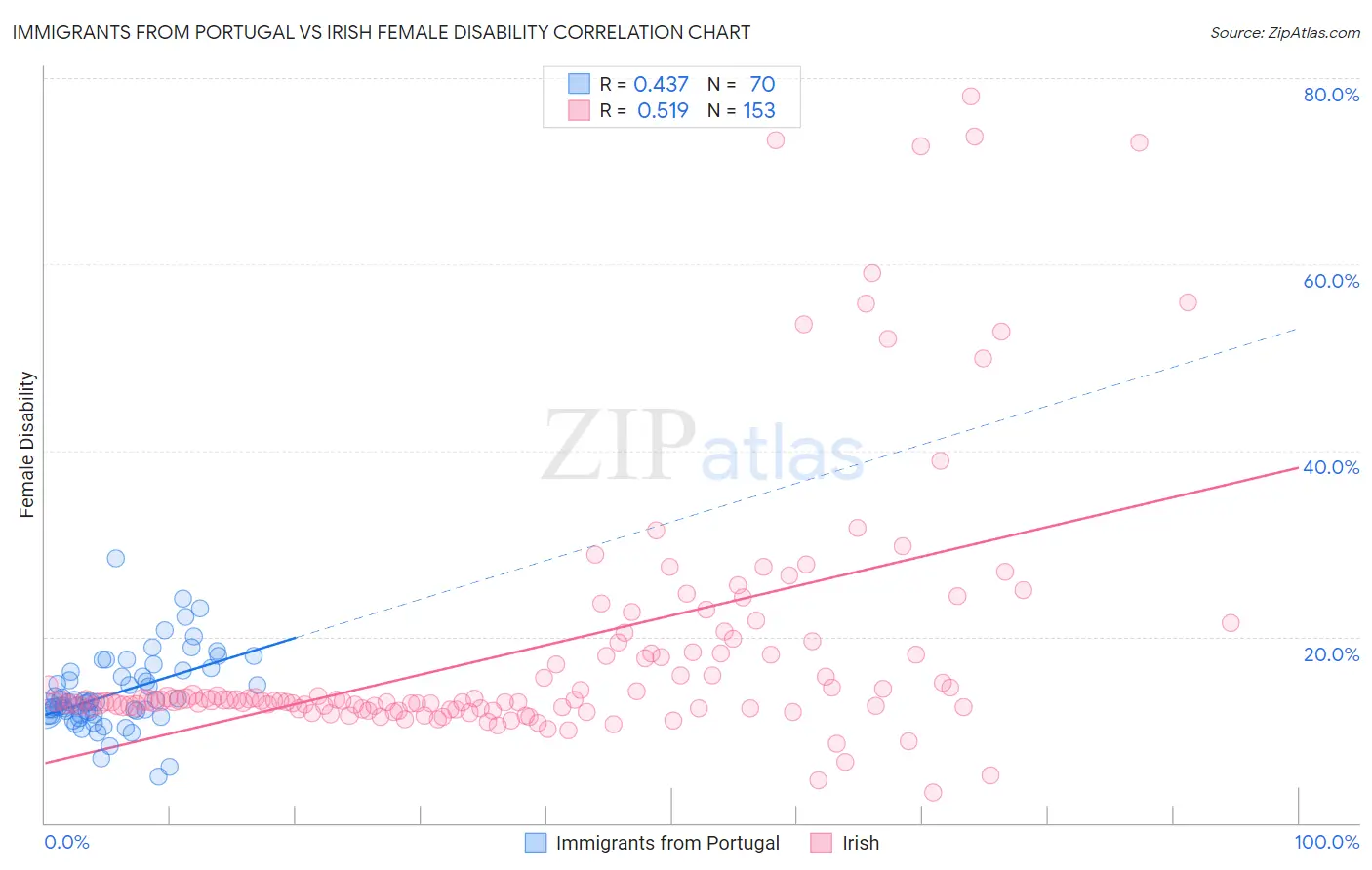Immigrants from Portugal vs Irish Female Disability
COMPARE
Immigrants from Portugal
Irish
Female Disability
Female Disability Comparison
Immigrants from Portugal
Irish
13.5%
FEMALE DISABILITY
0.0/ 100
METRIC RATING
303rd/ 347
METRIC RANK
13.1%
FEMALE DISABILITY
0.1/ 100
METRIC RATING
280th/ 347
METRIC RANK
Immigrants from Portugal vs Irish Female Disability Correlation Chart
The statistical analysis conducted on geographies consisting of 174,785,293 people shows a moderate positive correlation between the proportion of Immigrants from Portugal and percentage of females with a disability in the United States with a correlation coefficient (R) of 0.437 and weighted average of 13.5%. Similarly, the statistical analysis conducted on geographies consisting of 580,159,528 people shows a substantial positive correlation between the proportion of Irish and percentage of females with a disability in the United States with a correlation coefficient (R) of 0.519 and weighted average of 13.1%, a difference of 3.0%.

Female Disability Correlation Summary
| Measurement | Immigrants from Portugal | Irish |
| Minimum | 5.0% | 3.2% |
| Maximum | 28.4% | 78.1% |
| Range | 23.4% | 74.9% |
| Mean | 14.0% | 18.7% |
| Median | 12.9% | 13.2% |
| Interquartile 25% (IQ1) | 11.7% | 12.4% |
| Interquartile 75% (IQ3) | 16.3% | 18.3% |
| Interquartile Range (IQR) | 4.6% | 5.9% |
| Standard Deviation (Sample) | 4.1% | 14.2% |
| Standard Deviation (Population) | 4.0% | 14.1% |
Similar Demographics by Female Disability
Demographics Similar to Immigrants from Portugal by Female Disability
In terms of female disability, the demographic groups most similar to Immigrants from Portugal are Scotch-Irish (13.4%, a difference of 0.0%), Immigrants from Micronesia (13.5%, a difference of 0.030%), African (13.4%, a difference of 0.14%), Pennsylvania German (13.4%, a difference of 0.34%), and Dominican (13.5%, a difference of 0.34%).
| Demographics | Rating | Rank | Female Disability |
| Nepalese | 0.0 /100 | #296 | Tragic 13.3% |
| Slovaks | 0.0 /100 | #297 | Tragic 13.3% |
| Immigrants | Nonimmigrants | 0.0 /100 | #298 | Tragic 13.4% |
| Immigrants | Dominican Republic | 0.0 /100 | #299 | Tragic 13.4% |
| Pennsylvania Germans | 0.0 /100 | #300 | Tragic 13.4% |
| Africans | 0.0 /100 | #301 | Tragic 13.4% |
| Scotch-Irish | 0.0 /100 | #302 | Tragic 13.4% |
| Immigrants | Portugal | 0.0 /100 | #303 | Tragic 13.5% |
| Immigrants | Micronesia | 0.0 /100 | #304 | Tragic 13.5% |
| Dominicans | 0.0 /100 | #305 | Tragic 13.5% |
| French Canadians | 0.0 /100 | #306 | Tragic 13.6% |
| Central American Indians | 0.0 /100 | #307 | Tragic 13.6% |
| Cree | 0.0 /100 | #308 | Tragic 13.7% |
| French American Indians | 0.0 /100 | #309 | Tragic 13.7% |
| Apache | 0.0 /100 | #310 | Tragic 13.7% |
Demographics Similar to Irish by Female Disability
In terms of female disability, the demographic groups most similar to Irish are U.S. Virgin Islander (13.1%, a difference of 0.030%), Arapaho (13.0%, a difference of 0.090%), Welsh (13.1%, a difference of 0.11%), English (13.1%, a difference of 0.12%), and Hmong (13.1%, a difference of 0.25%).
| Demographics | Rating | Rank | Female Disability |
| Sioux | 0.1 /100 | #273 | Tragic 12.9% |
| Portuguese | 0.1 /100 | #274 | Tragic 13.0% |
| Cheyenne | 0.1 /100 | #275 | Tragic 13.0% |
| Immigrants | Dominica | 0.1 /100 | #276 | Tragic 13.0% |
| Spanish | 0.1 /100 | #277 | Tragic 13.0% |
| Scottish | 0.1 /100 | #278 | Tragic 13.0% |
| Arapaho | 0.1 /100 | #279 | Tragic 13.0% |
| Irish | 0.1 /100 | #280 | Tragic 13.1% |
| U.S. Virgin Islanders | 0.1 /100 | #281 | Tragic 13.1% |
| Welsh | 0.0 /100 | #282 | Tragic 13.1% |
| English | 0.0 /100 | #283 | Tragic 13.1% |
| Hmong | 0.0 /100 | #284 | Tragic 13.1% |
| Bangladeshis | 0.0 /100 | #285 | Tragic 13.1% |
| Fijians | 0.0 /100 | #286 | Tragic 13.1% |
| Yaqui | 0.0 /100 | #287 | Tragic 13.2% |